On land with no permanent water source, rain harvesting is the only way to provide reliable supplemental water for wildlife. (Well, you can lug it in on your back or a cart or trailer, but that’s no fun at all when temperatures top 100F day after day.) And rainwater is a healthier source of water for some (most?) wildlife than treated city water, even if that were affordable and available. Supplying supplemental water is a key activity in the support of wildlife, critical in times of drought. So, over the years, we’ve built “rain barns” to capture and store rainwater for this purpose. We also do rainwater collection off existing roofs (house, carport, horse barn) to provide water for the horses, water garden, and a few trees.
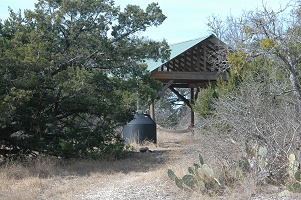 Fox Pavilion: 610 gallons storage max
Fox Pavilion: 610 gallons storage max
Fox Pavilion was our first, designed to supply water to a ~35 gallon capacity water source circulated by a small solar panel. You can see one of the 305 gallon storage tanks; the image below shows the waterer, hoses, and in the distance the solar panel on an overturned tub. Except for the occasional chewed-through wire, this setup has functioned well for about 8 years now, with daily checks in hot weather to top up the water from the tanks.
Though Fox Pavilion–built on the rocky “knoll” with brush growing around it–did serve wildlife, it was only a small source, and easily overwhelmed during drought periods. It was fine for small birds who preferred to drink alone or in small groups, but watching a flock of 30-odd cedar waxwings there suggested that we needed another design to serve birds that like to flock to water (and who, bathing, splash a lot of it out.
So our next rain barn, Owl Pavilion, was planned for more water storage (2500 gallon tanks instead of 305 gallon) and (to compensate for the space lost to the tanks) an observation deck that also provided shade in very hot weather.
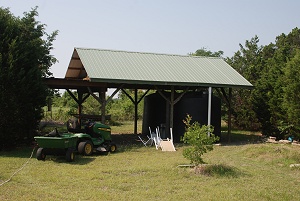 Observation deck on east (left) end, 5000 gallons storage
Observation deck on east (left) end, 5000 gallons storage
Owl’s water feature, with roughly 500 gallons of capacity, includes a “rock spring” and two preformed tubs deep enough and large enough to allow planting aquatics to help filter the large nitrogen load more birds were expected to dump–and offered reproductive space to odonates and amphibians. It was quickly colonized, after planting, with cricket and leopard frogs and several species of odonates, as well as other invertebrates.
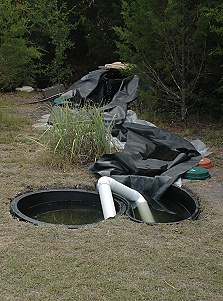 Owlstream being laid out; pump is in round tub and also powered by solar panel
Owlstream being laid out; pump is in round tub and also powered by solar panel
 Birds quickly discovered “spring” from between rocks.
Birds quickly discovered “spring” from between rocks.
We soon discovered that–as we’d suspected–different species chose different watering holes. The two rain barns were built in and near different habitats.
The newest rain barn, Cloud, suffered construction delays due to health setbacks, but is now almost finished. It benefited from our previous experience, even so. Like the other two, it has the same size roof area (and thus collection area) of just about 400 square feet. Like Owl, it has two 2500 gallon tanks for storage. In addition, it has an observation platform at each end, allowing additional viewing areas (and a different view from each end.) This also made it possible to raise the roof more safely, and with fewer helpers.
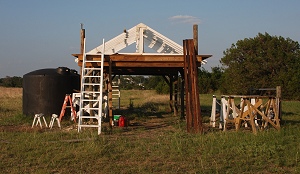 View from west several weeks ago. Roof trusses up, purlins on.
View from west several weeks ago. Roof trusses up, purlins on.
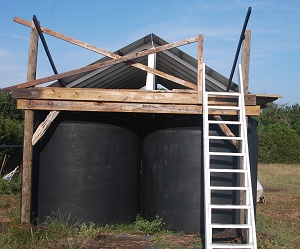 Cloud from east today, with tanks in place, roof on.
Cloud from east today, with tanks in place, roof on.
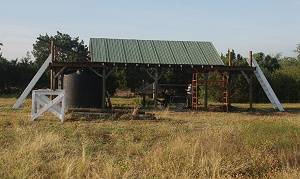 Cloud Pavilion from north; 5000 gallons storage
Cloud Pavilion from north; 5000 gallons storage
When it’s completely finished (all gutters and downspouts installed) and the ladders are painted a less intrusive color, then it will be time to install the waterer itself, and the solar powered pump…and wait for rain to fill the tanks. In the meantime, wild things are already interested in the rain barn, just as another habitat for exploration. Birds, lizards, insects–and judging by scat, another gray fox and perhaps a coyote–have checked it out.
Rain barns were named by what we’d seen in their location: gray foxes near Fox while we were building it, a Great Horned Owl near Owl before we built it, and lots and lots of clouds from Cloud, any time there are clouds in the sky. I’d like to put another two on the place sometime–one in the east end near the secondary drainage, to make a permanent waterhole out of one of the natural pools, and one in the northwest meadow (to balance Owl in the southwest.) In a drying and warmer climate, the more water we can store on the place, the better for wildlife and native plants both. We’re still over 12 inches “behind” normal rainfall since last October, and the only reason it’s not worse was the 12 inch deluge in September (rain falling so hard and fast that it didn’t really restore our groundwater–it just ran off.)
Rain harvesting is the logical way to provide reliable water for wildlife (and people, if you have the roof area and know how to purify it!) and there’s no reason not to build rain barns that function for more than one purpose.
With the addition of a couple of chairs and maybe a hammock (I vote for both!) you have a shaded area to rest in and observe from when you’ve hiked out to check the pump in hot weather. You also have a roof closer than the house to run to when caught out by a storm. You can stow supplemental feed (if you do that), tools, other equipment, and supplies under cover; you can have the same convenience for visitors (and, if there’s a group coming, you can pre-position an ice chest for them.) If you use a four-wheeler or other small vehicle to move around the place, you can park it where the seat doesn’t turn into a griddle.
Water yield: an inch of rain falling on 1000 square feet of roof will yield 600 gallons of water, on average. (720 gallons falls on 1000 square feet, but you won’t catch it all. Metal roofs are more efficient than asphalt-shingle roofs.) So for a 400 square foot collection area, you’ll get 0.4 x 600 gallons, or 240 gallons. Each side of the pitched roof will–in theory, with rain falling straight down–get 120 gallons (each side has a collection area of 200 square feet.) Thus three inches of rain will fill–overfill–a 300 gallon tank draining one side of that roof.
If you live where rain falls seldom, but heavily when it does–or falls for only one short part of the year–then you want to have the storage capacity to collect and store that maximum rain. For us, that means having the storage capacity to hold at least 7 inches of rain (1/4 normal annual rainfall) because 24 hour rains in the 5-8 inch range occur almost every year, as do months without rain at all. (We had a 7 inch rain shortly after finishing the horse barn and hooking up the new tanks–it filled them, just as calculations suggested it would.) It would be better to have over 12 inches of storage, but that’s going to take buying and linking more storage tanks. Owl and Cloud, with smaller collection area for the 2500 gallon tanks, can hold between 9 and 10 inches of rainfall. We really need more storage at Fox: in the current drought, we’ve come close to bottoming out the tanks there, since they can’t hold even a full three inches of rain. 600 gallons of storage was fine from 2003 through 2007, but it’s just barely adequate now. We’re considering ways to add storage without destroying more of the limited “dry brush” habitat (which is very attractive to some wildlife.) Easiest will be hauling two more 305 gallon tanks up there and connecting them in series.
How much storage is needed depends heavily on climate and rain patterns–the longer between rains, the more capacity you need; the hotter the climate, the more capacity you need; the fewer other water sources for wildlife, the more capacity you need; the more water in the actual water feature, the more capacity you need. Consider surface area and placement as well as total volume of water: shallow open ponds (very attractive to some wildlife, not to others) lose water to evaporation in hot weather faster than deep, narrow ones.
Consider aesthetics, too. There’s no reason to ignore what your rain barn looks like….its overall proportions can be attractive without adding to the cost or the difficulty of building it. (Having a soft green roof color instead of blinding “silver” did cost a bit more–but it looks that much better to us.) There’s no reason to avoid making the waterer itself attractive…when you come into the shade after a morning’s work on fencing or mowing or some other chore, why not have a pretty wildlife waterer with the sound of water dripping? Birds like it, and you can, too.
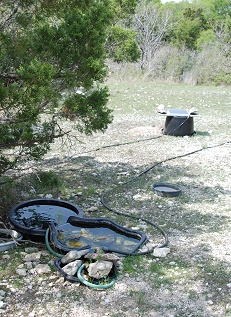
Comment by ajlr — June 23, 2011 @ 1:37 pm
That’s really fascinating, Elizabeth, thank you. Coming from a comparatively well-watered part of the world (SE England) I’d not heard of rain barns as a building type before reading this blog. Do you ever position one of the wildlife pools under the shade of the barn roof, to cut down on evaporation from direct sunlight, or is it best not to do that?
Comment by Caryn — June 23, 2011 @ 1:49 pm
Fascinating. Thank you.
This also explains why our small rain barrel is mostly useless in our climate — too small to hold the enormous amounts of rain we get all year, so we have to let it run out, but then we forget to close it for summer use of watering the tiny patch of raspberry bushes. Have to think on this.
Comment by elizabeth — June 23, 2011 @ 3:21 pm
ajlr: We position the water in available shade (at least partial) but not inside the rain barn–at a comfortable distance for wildlife, from those who may be in the barn, but with some unobstructed sight lines for photography. That will be a challenge at Cloud, which is out in the grassland; we’ll probably site the water near that patch of bushes.
I know that at least one UK book on water gardens recommends not having them in shade (leaves fall in, discolor water, etc.) but here any small natural water source that survives in summer does so in natural shade.
Caryn: I don’t know how your water barrel is designed, or how long you need to water raspberries or other food garden plants. If you can figure an amount for that need–X gallons/day for Y days–you can install a tank that size, let it fill, and then just hold the water until need. It’s possible to install a drip irrigation system directly off a tank that gives enough “head” (vertical distance, thus water pressure.) If we ever get the other house (was my mother’s house) guttered and storage tanks installed, we’d be able to water our vegetable garden and nut trees w/o any danger of breaking the water restrictions our town has every summer.
Comment by Gloria Oliver — June 23, 2011 @ 3:24 pm
That’s quite cool!
Hadn’t heard of rain barns before. Nice of you all to help the wildlife out like this. Bet you get to see all sorts of cool critters because of it too.
Way awesome! Thanks for sharing this.
Comment by elizabeth — June 23, 2011 @ 8:31 pm
Some of the pictures of Fox and Owl are the same as an earlier post about supplemental water, http://www.80acresonline.org/blog/?p=394, and discussion there goes into issues of water quality, site choice, etc., esp. in comments. I really should begin moving some blog posts into articles for the main website.
Comment by Martin LaBar — June 25, 2011 @ 2:16 am
Great idea, well carried out.
Comment by Chuck — January 26, 2016 @ 12:45 pm
I was talking to my dad about this as a way to provide water on his land (he’s selling the house and 10 acres but is keeping about 50, which has springs in wet weather only). He was concerned about evaporation from the tanks. At first I thought he was talking about the storage tanks, but I suppose he’s talking about “stock tanks,” i.e., the watering holes supplied by the recovery system. He said I’d be surprised how much evaporates daily. Do your smaller-capacity water supplies ever go dry because of evaporation? (Like springs do in droughts)
Comment by elizabeth — June 4, 2016 @ 9:45 pm
Water in the tanks we used (enclosed but for small opening at the top, which is then protected by screening from mosquitoes and rocks to protect screen and also filter out large trash–leaves, etc., and the hose bib at the bottom that controls outflow.) So no evaporative loss. In very hot weather, water may evaporate inside but then condenses and runs back in. On the big tanks (the 2500 gallon ones are the ones we call “big”) water temperature self-moderates between the day’s heat and night’s cool–you can check the water level when a tank is in the sun by running your hand down the side–you can feel the exact level where the water is by the temp. change.
Yes, open water evaporates at a very fast rate in hot weather. If you look up the tables for evaporative loss in open tanks and reservoirs, many FEET of water are lost that way in summer. That’s why narrow deep reservoirs store water better than wide shallow ones. Wide and shallow is a good way to accumulate salts and lose your water: salts from animal waste and the soil will be concentrated in the water as it evaporates and you can eventually get a “hardpan” or “salt pan” depending on how often it dries out completely. Anything that causes splashing (like a fountain) loses more water than water lying still. We lose water from the lily pond in the yard every summer–3-4 inches a day when it’s over 100 and the humidity’s down at 20% or so.
Ideally, if you have power for a pump, a really big tank set underground, so you can pump the water where you need it, will last longest and maintain the most stable temperature–it’s like your own private aquifer. Expensive as the dickens, though. I would love to have a 50,000 gallon underground tank, with all the roofs in the house area running into it–house, barn, carport–but short of a lottery win, it’s not happening. But that and a solar power setup would provide a lot of security. Run one pipe out for potable water, through a treatment setup, the other is for other uses–garden, stock watering, etc. We’ve discussed this, but the numbers are ferocious.